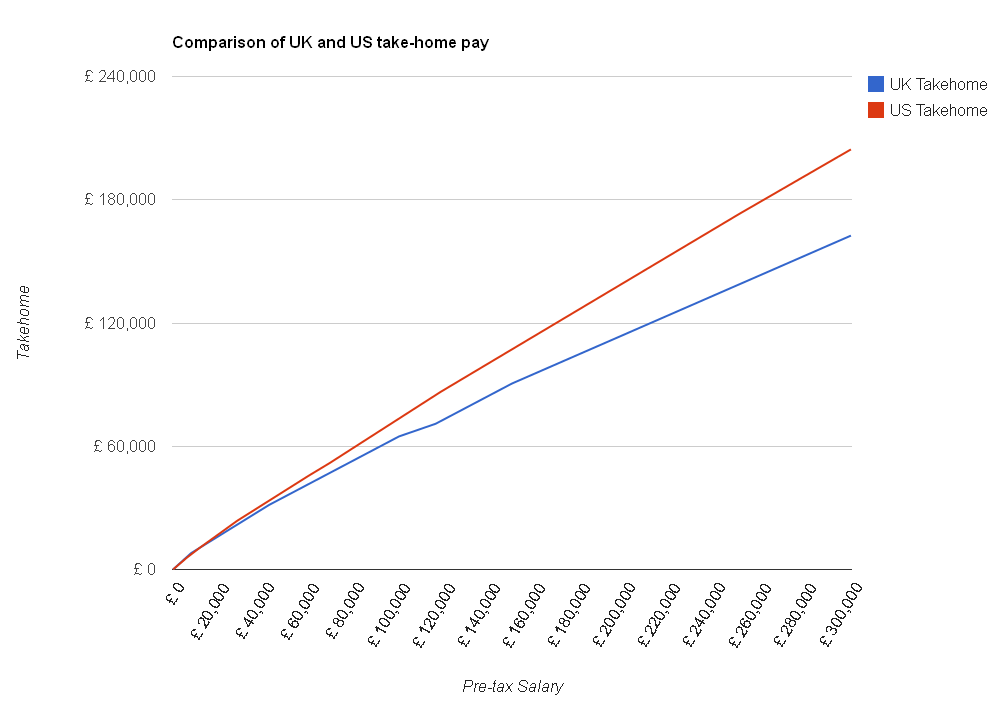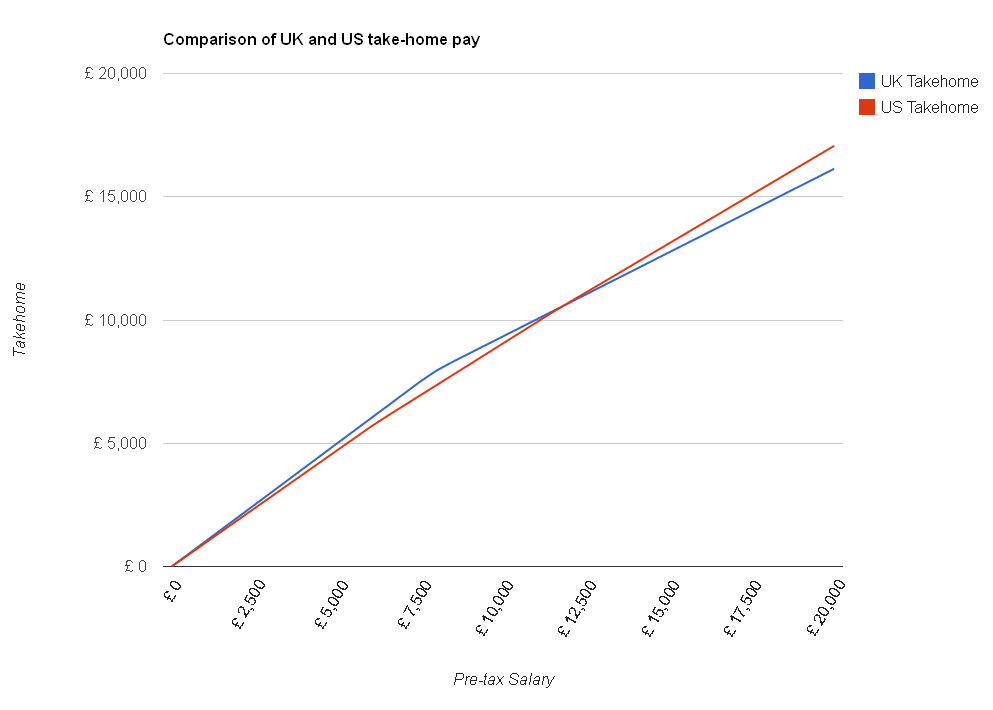Pay As You Earn
What would a 30% flat tax be like?
Earlier this month, the 2020 Tax Commission published a report promoting replacement of our current income tax system, which has varying rates of tax (from 20% to 50%) and National Insurance (typically 12% and 2%), with a simpler system which has a single flat tax at a rate of 30%. They also recommended raising the personal allowance (the amount you can earn tax-free) to £10,000 per year, from its current £8,105.
I thought it would be interesting to see how this plan, if implemented, would affect us when we get paid each month. The following chart compares the April 2012 tax rates in blue with the simplified version in red:
As you can see, under this proposal everyone who currently pays tax on employment would take home more money each month, as the total amount due would be less. The 2020 Tax Commission say that as part of this plan, schemes that currently allow people to take income through a business, avoiding National Insurance, would be removed. This might mean that people who are using such schemes to avoid tax at the moment would pay more under the proposal.
But, as you’ve probably realised, if (almost) everyone is paying less tax, that means the Government will get less money. This is indeed true – the gap between the two lines on the chart represents how much less the Government would get each year – and the commission also recommend abolishing inheritance tax and similar taxes, which would further reduce Government income. This would mean further cuts in public spending – which would be difficult to swallow at the moment. More reaction on the report is in this useful BBC article.
None of the content on this website, including blog posts, comments, or responses to user comments, is offered as financial advice. Figures used are for illustrative purposes only.
Student Loan repayment threshold
Those of you who are repaying your Student Loan through PAYE might have noticed that this month your student loan deduction is a little lower than usual (£5-£6 lower). This is because the annual threshold for student loan repayments increased in April from £15,000 to £15,795.
Income-contingent Student Loans are repaid from the April after you complete your course, at a rate of 9% on any gross income above this threshold. This is similar to the way income tax is calculated – i.e. a percentage of any income above a certain “free” allowance. However, while the tax-free allowance usually increases by a small amount each year, the student loan repayment threshold has been steady at £15,000 since April 2005 – before that, it was £10,000. If you’ve been paying off your student loan for a few years now, you may be surprised to see this change. More information is available from the Student Loan Repayment site. The Salary Calculator is up-to-date with this change to the repayment threshold.
If you are repaying your student loan and you think you might be close to paying it off, this earlier blog post about Student Loan over-repayment may be of interest to you.
Pro-rata Salary Calculator added
For a very long time, people have been asking me to add a pro-rata tax calculator to The Salary Calculator – I have finally created it and added it to the site. As I have mentioned in an earlier post, pro-rata salary is normally calculated quite easily. For reduced hours, most employers will multiply the full-time salary by the reduced number of hours divided by the full-time hours.
For example, if the full-time salary is £20,000 per year for 37.5 hours’ work per week, the pro-rata salary based on a 18-hour working week would be:
£20,000 x (18 / 37.5) = £9,600
Income tax, National Insurance and other deductions are then calculated based on this new salary. To use this new tool, you just need to enter the full-time salary, the full-time hours, and the new hours that the pro-rata salary is to be calculated from. To check it out for yourself, get started with the pro rata Salary Calculator.
Comparison of UK and USA take home
You may not know that there is a US version of The Salary Calculator which calculates take-home pay after income tax and Social Security (which is like the UK’s National Insurance). I thought it would be interesting to see how much of their salary our American cousins get to keep compared with how much we get to hold on to over here. I used an exchange rate of $1.59 to the pound, and the 2012 tax rates for both countries, to create this chart:
As you can see, in most cases the Americans get to keep more of their hard-earned cash than we do. The top rate of federal income tax is 35% in the USA, and they only start to pay that if they earn more than $398,100 in a year – compared with 40% tax in the UK if you earn more than £42,475 and 50% if you earn more than £150,000. Also, Social Security is charged at 5.65% of most incomes, compared to National Insurance which is calculated at 12% (although only above income of £7,605 per year). You might have heard in the news some people saying that the 50% tax rate makes Britain unattractive for wealthy business people – this is what they are talking about – if you could run the same business in the USA and pay tens or hundreds of thousands less in tax each year, you’d think about moving – making any British employees you have redundant and employing Americans instead.
However, before you start packing your bags, there are a few other things to consider. Firstly, you can see from this zoomed-in version of the chart that if you earn less than about £12,000 per year, you actually get to keep more of it here in the UK than you would in the US:
Also, these calculations only include federal income tax and Social Security – most of the states charge separate income tax on top of what the central government takes, which The Salary Calculator doesn’t currently work out. Another consideration is that in the UK we can rely on the NHS to provide us with healthcare if we need it either for free or for a relatively small prescription charge, but in the USA health insurance can cost thousands of dollars per year.
Also, it can be difficult to get a decent cup of tea.
You can read more about US tax rates on The Salary Calculator (US).
Employed and Self Employed
The Salary Calculator attempts to show you your take home pay after tax, National Insurance, pension deductions and Student Loan repayments – based on the assumption that you are an employee, and your employer will be making these deductions from your payslip by Pay As You Earn (PAYE). However, if you are self employed, tax and National Insurance is calculated differently, and you have to tell HMRC about your income, and then pay them what you owe directly.
If you are both employed and self employed at the same time, or change from employment to self employment during the tax year, your tax liability can be quite complicated. Your employment income will have been taxed by your employer, but the amount of self employment tax and National Insurance you pay will be affected by how much you have already paid through normal employment.
A new sister site for The Salary Calculator has been launched to try to help in this situation. Simply called Employed and Self Employed, there is plenty of information available and links to details from HMRC. There is also a complex tax calculator which will try to estimate your tax liability based on the information you provide.
Tax and National Insurance details which take effect from 6th April 2012 are applied, although previous tax years from 2009 onwards are also available for calculations (including the current 2011 tax year). If you are interested in the figures involved, you can check out the details page which contains detailed information from HMRC.
Categories
Tags
-
50% tax
2022
April 2010
April 2011
April 2012
budget
coronavirus
cost of living crisis
covid-19
debt
dollar
economics
Economy
election
Employed and Self Employed
Foreign Currency
foreign exchange rates
HMRC
holiday
holiday money
house prices
houses
income tax
interest rates
Jobs
Loans
Mortgages
national insurance
Pay As You Earn
pension
Pensions
personal allowance
pound
recession
recovery
savings
Self Assessment
self employed
self employment
student loans
tax rates
The Salary Calculator
unemployment
us
VAT
Sponsored Links
Archive
- May 2025
- April 2025
- March 2025
- November 2023
- September 2023
- August 2023
- July 2023
- June 2023
- May 2023
- April 2023
- March 2023
- February 2023
- January 2023
- December 2022
- November 2022
- October 2022
- September 2022
- August 2022
- July 2022
- June 2022
- May 2022
- April 2022
- March 2022
- February 2022
- January 2022
- December 2021
- November 2021
- October 2021
- September 2021
- August 2021
- July 2021
- June 2021
- May 2021
- April 2021
- February 2021
- January 2021
- December 2020
- November 2020
- October 2020
- September 2020
- August 2020
- July 2020
- June 2020
- May 2020
- April 2020
- March 2020
- February 2020
- November 2019
- September 2019
- April 2019
- March 2019
- December 2018
- April 2018
- March 2018
- January 2018
- May 2017
- March 2017
- February 2017
- September 2016
- June 2016
- March 2016
- February 2016
- January 2016
- June 2015
- April 2015
- March 2015
- February 2015
- January 2015
- November 2014
- October 2014
- July 2014
- June 2014
- May 2014
- March 2014
- February 2014
- January 2014
- November 2013
- October 2013
- August 2013
- July 2013
- June 2013
- May 2013
- April 2013
- March 2013
- February 2013
- January 2013
- December 2012
- November 2012
- October 2012
- September 2012
- August 2012
- July 2012
- June 2012
- May 2012
- April 2012
- March 2012
- February 2012
- January 2012
- December 2011
- October 2011
- May 2011
- April 2011
- March 2011
- January 2011
- December 2010
- August 2010
- July 2010
- June 2010
- May 2010
- April 2010
- March 2010
- February 2010
- January 2010
- December 2009
- November 2009
- October 2009
- September 2009
- August 2009
- July 2009
- June 2009


